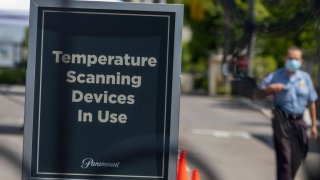
Los Angeles County officials reported 1,003 newly confirmed cases of the coronavirus and 17 additional deaths Sunday, bringing the county's totals to 73,018 cases and 2,907 deaths.
The numbers came two days after health orders were relaxed again in the county, allowing businesses such as museums, gyms, galleries, RV parks and zoos to reopen, provided they impose restrictions such as ensuring social distancing and requiring face coverings for employees and visitors.
"So many have lost loved ones and friends to COVID-19, and we mourn with you. You are in our thoughts and prayers every day,'' said Barbara Ferrer, the county's director of public health. ``For L.A. County to have a successful recovery journey, both businesses and residents must do their part to protect employees, customers and visitors. For businesses who are reopening, this means putting in place all of the required protocols for physical distancing and infection control before opening and ensuring that these protocols are followed by customers and employees every day."
Ninety-three percent of the county's deaths have occurred in people with underlying health conditions, a number that has been consistent throughout the pandemic.
On Thursday, the county reported its highest single-day total of new cases since the pandemic began -- 1,857 -- although it attributed about one-third of the cases to a backlog of testing results.
On Friday, the county reported another 1,633 confirmed cases, pushing the countywide total above 70,000, reaching 70,476. Ferrer again attributed about 500 of the day's new cases to a backlog of test results reported by a single lab.
Saturday's report brought news of another 1,568 cases.
U.S. & World
County health officials noted last week that the rate of spread of COVID-19 was inching higher, potentially threatening the availability of intensive-care unit hospital beds within two to four weeks.
The concerns, however, didn't stop the county from moving forward with its new health order, which as of Friday morning allowed the opening of:
-- gyms and fitness centers;
-- professional sports venues without live audiences;
-- day camps;
-- museums and galleries;
-- zoos and aquariums;
-- campgrounds and RV parks;
-- outdoor recreation such as swimming pools;
-- music, film and television production; and
-- hotels for leisure travel.
Movie theaters are not included in the new order, even though the state has released protocols allowing them to reopen if individual counties approve.
But just because the county has cleared some businesses to reopen does not mean all of them will automatically do so. The Los Angeles Zoo issued a statement Thursday saying it does not anticipate reopening until July, with officials still "making preparations" to resume operating.
For businesses and attractions that do reopen, restrictions will have to be enforced, including face coverings and social distancing and rigorous cleaning and sanitation regimens.
Ferrer stressed Wednesday that the reopening of more business sectors should not be seen as an indication the county is out of the woods in terms of the coronavirus pandemic, noting, "We're still in the middle of the woods and we have a lot of risk.''
She said it will remain important for residents to adhere to the health restrictions when visiting any reopened business, and for the businesses themselves to enforce them.
Highlighting the need for such precautions, health officials confirmed Wednesday there has been a slight uptick in the rate of the virus' spread in the county. At the height of the pandemic, people infected with COVID-19 transmitted the virus to an average of three other people. Under strict stay-at-home orders and business closures, that number fell to below one.
But in the weeks since businesses have been allowed to reopen and more people have been mingling in the community, that infection rate has now risen above one. The county's medical services director, Dr. Christina Ghaly, said the county has enough hospital beds to handle an increase in cases, but the higher infection rate could lead to a shortage of intensive-care beds within two to four weeks.
Ghaly said the county's modeling predicts ``the spread of COVID-19 in the Los Angeles County area is likely to increase gradually over time.'' She stressed that the predictions are based solely on actual hospitalization numbers, not on the increasing numbers of people who are leaving their homes and interacting with the public at newly reopened businesses or -- more recently -- massive protests against police brutality.



